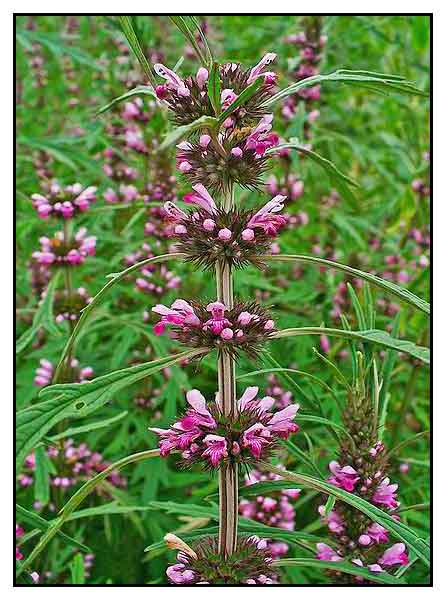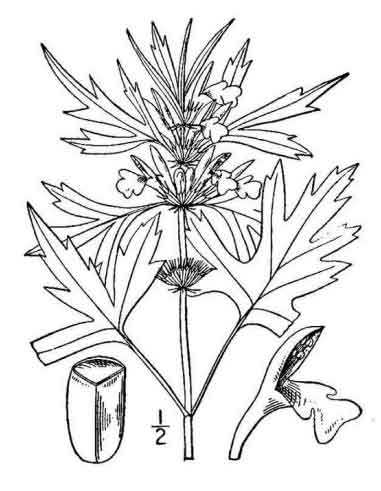 Botany Botany
Kamariang-sungsong is a rather coarse, erect, branched, somewhat hairy, annual herb, 60 to 120 centimeters high. Leaves are 5 to 10 centimeters long, pinnately or palmately 3- to many-parted; lobes are narrow and often incised, the upper leaves may be entire, linear and pale beneath. Flowers are crowded, occurring in numerous whorls. Calyx is about 7 millimeters long with triangular teeth. Corolla is about 1 centimeter long and red, the tube as long as the limb. Upper lip of the corolla is hooded and hairy, the lower equals the upper, and the two rounded lateral lobes.
Distribution
- Found in the Batan Islands and northern Luzon to Mindanao.
-
Widely scattered in waste places in and about towns.
- Introduced.
- Occurring in all warm countries.
Constituents
- Fresh leaves yield a crystalline principle, leonurine, and fixed oil 0.5 %.
- Calyx contains a trace of aromatic oil.
- Seeds contain leonurinine, volatile oil and fatty oil.
- Plant yields alkaloids: cycloleonurinine, leoheterin, leonurine, leonurinine, leuronurine, prehispanolone, preleoheterin, stachydrine.
-Study of leaves yielded four major flavonoids: quercetin-3-O-α-L-rhamnopyranosyl-(1>6)-β-D-galactopyranoside; rutin; hyperin, and isoquercetrin and three minor flavonoidic compounds- genkwanin, 3′-hydroxy genkwanin, and quercetin.
 - Study of aerial parts yielded two new furanoditerpene-lactones, LS-1 (1) and LS-2 (2), along with four known furanoditerpene-lactones 3, 4, 5 and 6. (see studies below) (7) - Study of aerial parts yielded two new furanoditerpene-lactones, LS-1 (1) and LS-2 (2), along with four known furanoditerpene-lactones 3, 4, 5 and 6. (see studies below) (7)
- Methanolic extract of aerial parts yielded two new phenols, yimunoside A and yimunol A, together with eight known compounds: 4-hydroxythiophenol, syringic acid, apigenin, luteolin-7-methylether, genkwanin, isoquercitrin, rutin, and 4-hydroxybenzoic acid.
(13)
- Study of aerial parts yielded seven new diterpenes, sibiricinones A-E and 15-epi-sibiricinones D and E, and the flavone genkwanin. (20)
- LC-MS/MS and HPLC analyses yielded nine phenolic compounds: catechin, verbascoside, two flavonoids (quercetin and rutin) and five phenolic acids (4-hydroxybenzoic acid, chlorogenic acid, caffeic acid, p-coumaric acid, and ferulic acid. Content of phenolic compounds in in-vitro raise plants was greater than levels in plants propagated by seeds. (see study below) (21)
- MS study of roots for essential oil yielded 85 components. Seventy components were identified for NR (normal root) EO, with major constituents of ß-selinene (9.9%), selina-4,7-diene (9.7%), (E)--[beta]-caryophyllene (73%), myli-4(15)-ene (6.4%), and guaia-1(10), 11-diene (5.9%), Sixty-seven components were identified for HR (hairy roots) EO, with main constituents of (E)-[beta]-caryophyllene (22.6%), and germacrene D (19.8%). (see study below) (25)
Properties
- Considered antibacterial, antispasmodic, astringent, alterative, depurative, diaphoretic, diuretic, tonic, nervine, hypnotic, vulnerary and emmenagogue.
- Has earned the name "marihuanilla" in South America and Mexico, smoked as a mild intoxicant, the effect attributed to leonurine.
Parts used
Roots, leaves, seeds, and juice.
Uses
Culinary
- Leaves and roots are edible; used as flavoring.
- Young shoots cooked, imparts a sweetish flavor.
- In Sarawak, herb used as a culinary ingredient.
Folkloric
- In the Philippines, decoction of the plant, taken internally as a diuretic.
- In Chinese medicine, all plants parts are used, especially the seeds. Used for postpartum hemorrhages and menstrual disorders. Used as a diuretic in the treatment of edema associated with acute nephritis. Herb used to treat loss of potency in men.
- Juice of leaves used for hemoptysis; infusion used for hysteria.
- In Malacca, poultice of plant used for headaches.
- In India, roots, leaves, and juice are bitter; an infusion used as febrifuge.
- In Java, infusion in spirits administered after childbirth.
- Plant used to stimulate uterine contractions.
- Used as tonic, alterative, vulnerary and general remedy in puerperal and menstrual disorders.
- Used as emmenagogue.
- Leaves used for rheumatism.
- Juice used for psoriasis, scabies,various skin eruptions.
- Leaves ingested to relieve menstrual pain and excessive bleeding.
- Tinctures used for rheumatic fever.
Others
- Marihuana substitute: In some countries, sold as marihuana alternative weed.
Studies
• Antiplatelet Effect / Leonurine: Study isolated leonurine from the aerial part of Leonurus sibiricus var. albiflora. Leonurine showed significant in vitro inhibition of rabbit platelet aggregation induced by thrombin, arachidoic acid and collagen. (1)
• Toxicological Studies: Study of the dried kacangma herb showed indications of renal and liver toxicity in the medium and high dose group with associated histopath effects. In the low dose group, no significant toxicity was noted. (2)
• Anti-Tumor Effects: Study evaluating the chemopreventive role of motherwort in lesions of the mammary gland and uterus of GR/A mice showed suppression of palpable mammary tumors and retardation of growth. There was no effect on pregnancy-dependent mammary tumors, mammary hyperplastic alveolar nodules or uterine adenomyosis. (3)
• Anti-Inflammatory: Study investigating the anti-inflammatory effect of motherwort showed inhibition of secretion of TNF-a (tumor necrosis factor), IL-6 and IL-8 possibly by inhibiting NF-kB activation. Results indicate MW may be helpful in regulating inflammatory diseases. (2) Study showed LS synergistically induces the production of NO and TNF-a by peritoneal macrophages when treated by recombinant IFN-[gamma](rIFN-[gamma]). Study results suggest LS influences NO and TNF-a production via NF--(kappa)B signaling pathway. (4)
• Antibacterial: Study of carbon tetrachloride and chloroform extracts of LS aerial parts showed a broad spectrum of antibacterial activity. (5)
• Hypolipidemic / Antioxidative / Anti-Atherogenic: Study showed LS herb extract supplementation may modulate lipoprotein composition and attenuate oxidative stress by elevated antioxidant processes with suppression of inflammatory mediators – a possible mechanism of an anti-atherogenic effect. (6)
• Cytotoxicity Against Leukemia Cells / Furanoditerpene-Lactones: Study yielded two new and four known furanoditerpene-lactones from the aerial parts of Leonorus sibiricus. The compounds exhibited moderate cytotoxic activity against leukemia cells in tissue culture. (7)
• NO and TNF-a Induction: Study showed LS synergistically induces the production of NO and TNF-a by peritoneal macrophages when treated by recombinant IFN-[gamma](rIFN-[gamma]). Study results suggest LS influences NO and TNF-a production via NF--(kappa)B signaling pathway. (8)
• Toxicity Studies: Toxicity of LS was evaluated in acute and subchronic studies on New Zealand male and female rabbits. No toxicity was seen on consumption at rate of 0.5 g/kbw (low dose) on a 90-day subchronic study. Some indications of renal and liver toxicities were noted in the medium and high dose groups. (12)
• In Vitro Cytotoxicity / Anthelmintic / Leaves and Roots: Study investigated the cytotoxic and anthelmintic activities of dried leaves and roots of Leonurus sibiricus. The crude methanolic extract and fractions showed significant cytotoxic activities. Crude methanol extract of roots also showed very good anthelmintic activities against earthworm Pheretima posthuma. (15)
• Enhanced Insulin Secretion: Study evaluated effect of extracts of L. sibiricus on insulin secretion, intracellular calcium concentration and cell proliferation of INS-1E insulinoma cells. Results showed enhanced insulin secretion and/or foster cell proliferation providing therapeutic principles for empirical use of LS containing formulations for use in DM and DM-related disorders. (16)
• Larvicide Potential: Study evaluated the in vitro efficacy of aqueous extracts of L. sibiricus from different parts of plant (stem and leaves) at different concentrations at the eclodibility eggs and larval mortality of helminths. Previous study has demonstrated larval mortality on equine strongyles larvae. Results showed treatment with aqueous extract of stems 10% showed best results of larvicide potential. (17)
• Antioxidant: Study evaluated antioxidant activities of ethanol and aqueous extracts of dried kacangma in three bioassay systems, viz., LP, XOD, and DPPH. Antioxidant activity was high in the LP system (72%), moderate in XOS (70%), and low in DPPH (49%). Water extraction was more efficient than ethanol in extracting antioxidant compounds. (18)
• Effect of Leaves on Cultivation of Essential Oil of Peppermint: Study showed various concentrations of methanolic extract of leaves applied to M. piperita plants influenced the levels of the components of essential oil. (19)
• Amelioration of Suppressed Lactation: Study evaluated the effect of L. sibiricus on lactation suppressed by pregnancy-dependent mammary tumors in GR/A mice. Results showed amelioration of lactation suppressed by PDMT through its stimulation of both growth and function of the mammary glands. (21)
• Antioxidant / Protective Against Oxidative DNA Damage: All tested extracts of L. sibiricus showed protective and DNA repair stimulating effects in Chinese hamster ovary (CHO) cells exposed to H2O2. The roots and aerial parts may be responsible for stimulation CHO cells to repair oxidatively induced DNA damage , as well as protecting DNA via enhanced activation of the antioxidant genes (SOD2, CAT, and GPx) regulating intracellular antioxidant capacity. (see constituents above) (23)
• Anticancer / Apoptosis Via DNA Damage / Human Cancer Cells: Study evaluated the potential of L. sibiricus extract derived from in vitro transgenic roots on grade IV human glioma cells and U87MG cell line. The anticancer effect induced by the extract was associated with DNA damage PARP cleavage/increased H2A.X histone levels and down-regulation of mRNA levels. Both tested extracts showed anticancer properties and better results for AtPAP1 with transcriptional factor root extract. Activity could be attributed to presence of higher condensed phenolic acids such as neochlorogenic acid, chlorogenic acids, ferulic acid, caffeic acid and p-coumaric acid. (24)
• Antibacterial / Anti-Inflammatory / Antioxidant / Antiproliferative / Essential Oils of Roots: GC- Roots essential oils (HR and NR) showed activity against grande IV glioma cell lines, antimicrobial and anti-inflammatory activity. The EO showed moderate antioxidant activity in ABTS assay. Results suggest potential application in the food and pharmaceutical industries. (see constituents above) (25)
• Herb-Drug Interaction: Major: Sedative medications (CNS depressants) interact with motherwort, which may cause increase sleepiness and sedation; ex: clonazepam, lorazepam, zolpidem, etc. (26)
• Promotion of Osteoblast differentiation / Inhibition of Osteoclast Formation: Study demonstrated Leonurus sibiricus may promote osteoblast differentiation and suppress osteoclast differentiation in vitro, and inhibited lipopolysaccharide (LPS)-induced bone loss in a mouse model. LS inhibited the reduction in bone mineral density and bone volume/total volume ratio in a mouse model of LPS-induced osteoporosis. Results suggest LS has potential in the treatment of osteoporosis and other metabolic bone diseases. (27)
Availability
- Wild-crafted.
- Tincture, extracts in the cybermarket.
|

![]()




 - Study of aerial parts yielded two new furanoditerpene-lactones, LS-1 (1) and LS-2 (2), along with four known furanoditerpene-lactones 3, 4, 5 and 6. (see studies below) (
- Study of aerial parts yielded two new furanoditerpene-lactones, LS-1 (1) and LS-2 (2), along with four known furanoditerpene-lactones 3, 4, 5 and 6. (see studies below) (